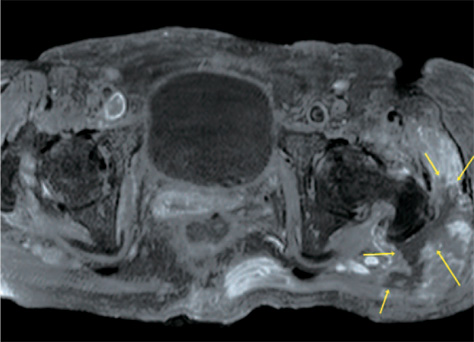Hip Pelvis.
2014 Dec;26(4):279-283. 10.5371/hp.2014.26.4.279.
Bilateral Necrotizing Fasciitis around the Hips Differentiated from Fournier Gangrene: A Case Report
- Affiliations
-
- 1Department of Orthopedic Surgery, National Police Hospital, Seoul, Korea. ish0524@hanmail.net
- KMID: 1907706
- DOI: http://doi.org/10.5371/hp.2014.26.4.279
Abstract
- As an emergency encountered in orthopedic practice requiring prompt diagnosis and aggressive treatment, necrotizing fasciitis around the hip must be discriminated from Fournier gangrene. The current case report describes a patient who suffered from bilateral type I necrotizing fasciitis around the hips, which was alleviated by prompt surgical debridement and intensive postoperative care.
Keyword
MeSH Terms
Figure
Reference
-
1. Lee ST, Lee SH, Kim KM, Lee SJ. Necrotizing fasciitis of the low extremity. J Korean Orthop Assoc. 2005; 40:772–777.
Article2. Shaikh N. Necrotizing fasciitis: a decade of surgical intensive care experience. Indian J Crit Care Med. 2006; 10:225–229.
Article3. Machado NO. Necrotizing fasciitis: the importance of early diagnosis, prompt surgical debridement and adjuvant therapy. N Am J Med Sci. 2011; 3:107–118.
Article4. Song SJ, Lee IS, Chung JH. Type I, II acute necrotizing fasciitis of the low extremity. J Korean Orthop Assoc. 2007; 42:636–643.
Article5. Kim JO, Cho HM, Sin WJ, Bong HS. Necrotising fascitis of the thigh through short external rotator muscles due to an unrecognized perforated rectal cancer. Hip Pelvis. 2013; 25:149–152.
Article6. Elliott D, Kufera JA, Myers RA. The microbiology of necrotizing soft tissue infections. Am J Surg. 2000; 179:361–366.
Article7. Wysoki MG, Santora TA, Shah RM, Friedman AC. Necrotizing fasciitis: CT characteristics. Radiology. 1997; 203:859–863.
Article8. Wall DB, Klein SR, Black S, de Virgilio C. A simple model to help distinguish necrotizing fasciitis from nonnecrotizing soft tissue infection. J Am Coll Surg. 2000; 191:227–231.
Article9. Mallikarjuna MN, Vijayakumar A, Patil VS, Shivswamy BC. Fournier's gangrene: Current practices. ISRN Surg. 2012; 2012:942437.
Article10. Bilton BD, Zibari GB, McMillan RW, Aultman DF, Dunn G, McDonald JC. Aggressive surgical management of necrotizing fasciitis serves to decrease mortality: a retrospective study. Am Surg. 1998; 64:397–400. discussion 400-1.




